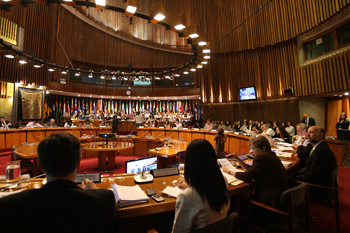ECLAC Describes Methodology to Measure Poverty in Chile in 2009
Topic(s)
Yesterday, the Commission presented its annual report with positive forecasts in terms of poverty reduction in the region.
(1 December 2010) The basic approach that ECLAC uses to estimate the magnitude of poverty is based on identifying poor households whose income is lower than a poverty line. This estimate reflects the value of goods and services needed to satisfy essential needs.
The poverty lines used were originally calculated using information on the consumption patterns of households, in terms of food and other goods and services, according to information from family budget surveys from the 1980s and early 1990s. In the case of Chile, the information came from the 1987-1988 Fourth Survey of Family Budgets.
In order to calculate poverty and indigence for each of the years for which an income measurement is available (for Chile, this means those years when a National Socio-economic Survey was carried out), the value of the original lines must be updated to reflect changes in the prices of goods and services. The practice traditionally employed by ECLAC was to update the values of the poverty and indigence lines by taking into account changes in food prices. This practice ensured that the ratio between the poverty and indigence remained constant.
From 2007, however, the indigence line for all countries was updated on the basis of variations in the food component of the Consumer Prices Index (IPC), whereas the poverty line for spending on non-food items was updated using the corresponding variation in the IPC. From 2007 onwards, the difference between the indigence and poverty lines was therefore no longer constant.
The criterion for updating the lines was changed as a result of the regional surge in food prices in 2007 and 2008, which was not accompanied by a similar rise in the price of other goods and services. Indeed, in Chile during the period 2006-2009, the CPI for food grew by 32.4%, while the CPI for other goods increased by just 6.4%.
Up to 2006, the Chilean Government's official estimate coincided with that of ECLAC. The difference seen for 2009 is because the Government did not adopt the change introduced by ECLAC, and continued to update the value of the poverty line as a whole (food and other goods and services) on the basis of changes in food prices (as has been the case since 2006).
The effect is particularly important for Chile, because its adoption changes the poverty trend in relation to the 2006 estimate. If the indigence and poverty lines are updated using the variation in food prices (which is the methodological option used by the Chilean Ministry of Planning and Cooperation (MIDEPLAN)), the resulting poverty rate is 15.1%, which represents an increase of 1.4 percentage points.
In contrast, using food price variations to update the value of the food basket and the variation in non-food prices to update the value of other goods and services, the resulting poverty rate is 11.5%, which is 2.2 percentage points lower than the figure for 2006.
It should be pointed out that the methodology of ECLAC and the Chilean Ministry of Planning and Cooperation are the same for the other parameters. At the same time, it is common for there to be differences in the estimates of ECLAC and official estimates from countries, given the different methodological options that exist for calculating poverty.
For further details, please contact the ECLAC Public Information and Web Services Section.
E-mail: dpisantiago@cepal.org; telephone: (56 2) 210 2040. ECLAC (Av. Dag Hammarskjold 3477, Vitacura, Santiago).
Related content

Poverty in Latin America Fell in 2010 and Returns to the Pre-Crisis Trend
Thanks to the region's economic recovery, the number of poor people will fall to the same levels as in 2008 (180 million inhabitants).
Country(ies)
- Latin America and the Caribbean
-
Chile
Contact
Public Information Unit
- prensa@cepal.org
- (56 2) 2210 2040